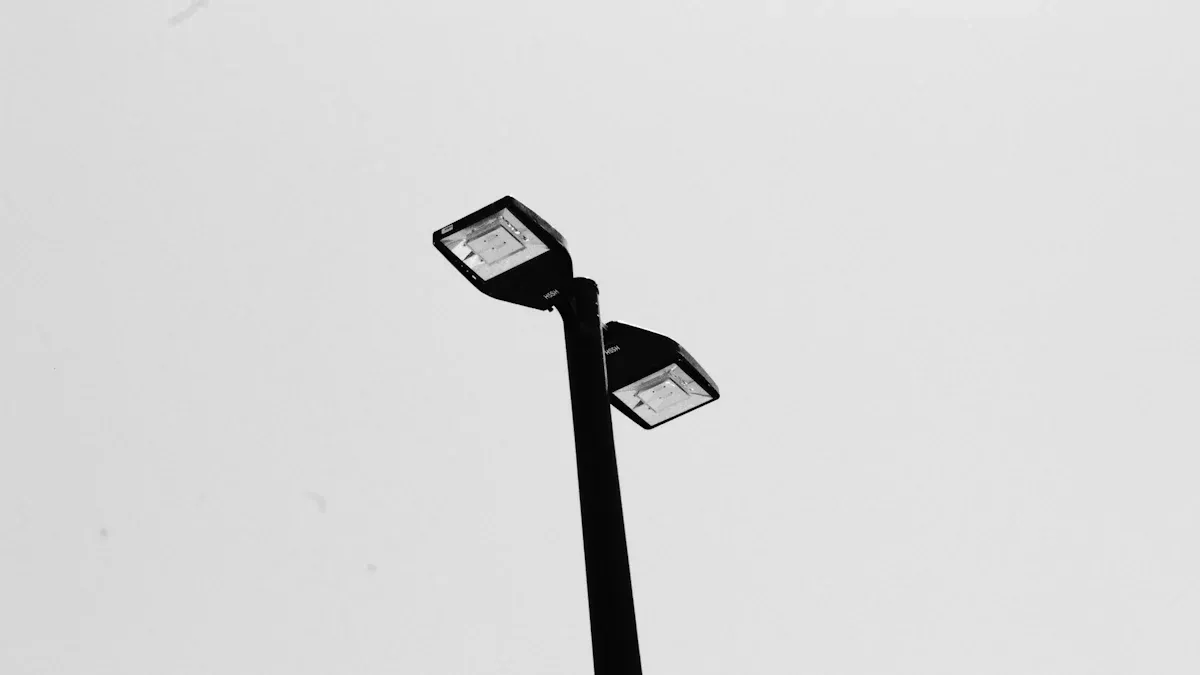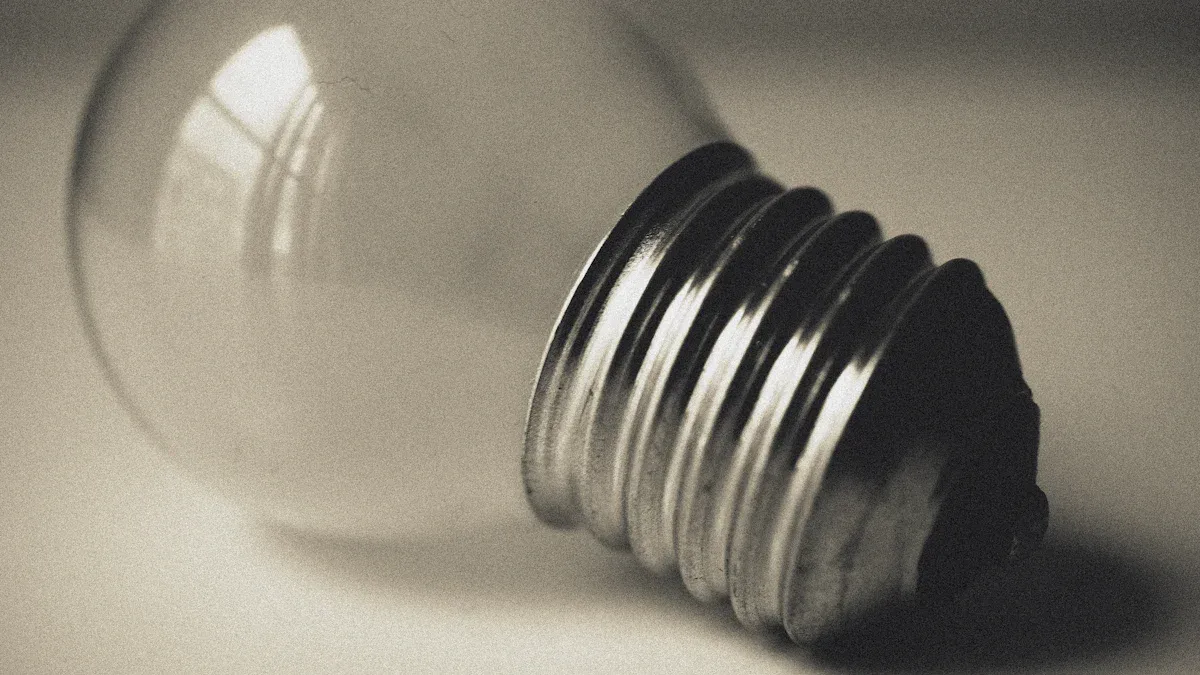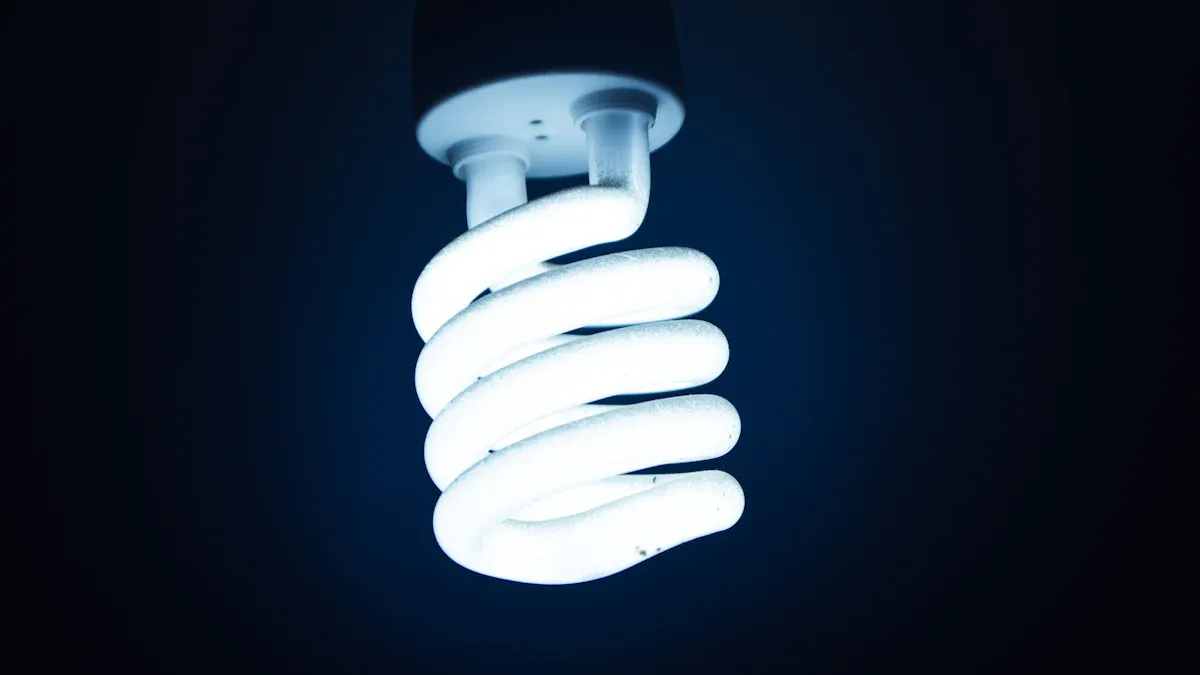Metal Halide Lamps: Benefits, Applications, and Comparison to LED Solutions

Most people now choose LED light over metal halide lamps for their home and business needs. LED lights use significantly less energy than metal halide lamps and have a much longer lifespan. Many companies and factories switch to LED lights to save money on energy bills and maintenance costs. While more people buy LED lights each year, the demand for metal halide lamps grows at a slower pace. When making decisions about lighting products, people consider energy efficiency, cost, durability, and maintenance frequency. They also focus on the quality of light produced. These factors help homes, public spaces, and businesses select the best lighting solutions. To learn more about our product offerings and the benefits of LED light and metal halide lamps, visit the About Us section on our website.
Key Takeaways
LED lights use less power. They last much longer. They do not need much fixing. This saves money over time compared to metal halide lamps.
Metal halide lamps give off strong, bright light. They work best in big, open areas. But they need time to get bright. You also have to change the bulbs often.
Changing from metal halide to LED lights can save 50-60% on energy and fixing costs. It also lowers heat and is better for the environment.
LED lights show colors better. They turn on right away and do not get as hot. This makes places more comfortable and safe.
Getting help from experts for lighting upgrades is smart. They help you pick the right LED lights. They make sure old lamps are removed safely. You get your money back faster.
Metal Halide Lamps Overview

How Metal Halide Lamps Work
Metal halide lamps are part of the high-intensity discharge group. These lamps make light by using an electric arc. The arc forms between two electrodes inside a small tube. This tube holds vaporized mercury and metal halides. Metal halides are made from metals and halogen elements like iodine or bromine. When you turn on the lamp, a starter electrode helps start the arc. The arc heats up the gas inside the tube. This heat turns the metal halides and mercury into vapor. As it gets hotter, the metal halides split into metal and iodine atoms. These atoms give off visible light when the arc excites them. The lamp needs about five minutes to warm up fully. During this time, the light gets brighter and the color gets better. The outer bulb is usually made from borosilicate glass. This glass protects the arc tube and blocks harmful ultraviolet rays. Because of this design, metal halide lamps make strong, bright white light. The light also shows colors well. This makes them good for many lighting jobs.
Common Uses of Metal Halide Lights
Metal halide lights are used in many businesses and factories. People pick these lamps for lighting big areas. You can find metal halide bulbs in parking lots, sports arenas, factories, and stores. They also light up bridges and tunnels outside. In businesses, these lights help keep people safe and let them see well. Sports places use metal halide lights to make fields and courts bright and even. Warehouses and factories use these lamps to work better. Some homes use metal halide lights for security. Other uses are car headlights, stage lights, and indoor plant or fish tank lights. But these uses are less common now because of LED lights. Metal halide lamps are still chosen for places that need strong, clear light.
LED Lights Overview

How LED Lights Work
LED lights use a solid-state device called a light emitting diode. When electricity flows through the semiconductor, it makes visible light. This is called electroluminescence. Metal halide lamps need time to warm up, but LED lights turn on right away. LED lights shine in one direction, so less energy is wasted.
Note: LED technology is different because it does not use gas or vapor. This makes LED lighting more efficient and dependable for many uses.
The table below shows the main differences between LED lights and metal halide lamps:
Aspect | LED Lights (Light Emitting Diode) | Metal Halide Lights |
|---|---|---|
Operating Principle | Solid-state semiconductor emits light | Gas discharge through metal halide vapor |
Light Directionality | Directional | Omnidirectional |
Warm-up Time | Instant on | 15-20 minutes |
Energy Efficiency | More efficient | Less efficient |
Lifespan | Longer | Shorter |
Maintenance | Lower | Higher |
Light Quality | High | High (cool color temperatures) |
Common Applications for LED Lights
LED lights are used in many places today. People put LED lighting in homes, offices, and public spaces. LED high bay lights are good for warehouses, factories, and sports arenas with tall ceilings. These lights give bright, even light and help keep people safe.
Commercial spaces: Stores and offices use LED lights to show products and make work areas comfortable. You can change the color and brightness to help people shop and work better.
Industrial settings: LED high bay lighting is used in warehouses and factories. It gives strong, steady light for safe work.
Outdoor and public areas: LED lights make streets, parking lots, and walkways brighter. Cities pick LED lighting to save energy and help people see better.
Healthcare and showrooms: Hospitals use LED lights to help patients and staff. Showrooms use LED lighting for both main and special lighting.
Agriculture: Farmers use LED lights in greenhouses and barns to help plants grow and care for animals.
LED technology works well in many places because it saves energy and lasts a long time. LED high bay lights, LED flood lights, and LED street lights all help lower maintenance and energy bills. These benefits make LED applications a smart choice for lighting today.
Metal Halide vs LED: Comparison
Energy Efficiency
When you compare metal halide and LED lights, you see a big difference in energy use. Metal halide lamps start out strong, making 75-100 lumens for each watt. But after some time, they lose power and drop below 30 lumens per watt. LED lights start at the same level but stay above 50 lumens per watt for a long time.
Lamp Type | Source Efficiency (lumens/watt) | System Efficiency (lumens/watt) |
|---|---|---|
Metal Halide | 75-100 | <30 |
LED | 75-100 | >50 |
Many groups that switch to LED lighting save about half on energy. For example, if you change a 400-watt metal halide lamp to a 150-watt LED, you use much less energy. This means you pay less for power and waste less energy. LED lights also keep their brightness longer, so they are better for saving energy over time.
Lifespan
How long a light lasts changes how much you spend and how often you fix it. Metal halide lamps work for 8,000 to 20,000 hours, but heavy use can make them stop sooner. Many people have to change these lamps every year or two. They also get dim fast because the parts inside wear out.
LED lights last a lot longer. Some LED lights work for 50,000 to 100,000 hours. The best ones can even go past 75,000 hours. LEDs keep most of their brightness as they age, but metal halide lamps can lose half their light before they break.
Lamp Type | Typical Lifespan (hours) | Notes |
|---|---|---|
Metal Halide High Bay (400W) | Needs several replacements to match LED life | |
60,000 | Lasts much longer than metal halide | |
LED High Bay (230W) | 75,000 | Up to 3.75 times longer than metal halide |
Maintenance
Maintenance is important when you look at metal halide and LED lights. Metal halide lamps need to be replaced often, usually when they reach 60% of their life. This means you have to change many bulbs at once to keep the light bright and the color good. You often need experts to help because it can be tricky and unsafe. Cleaning and checking the lights adds more work.
LED lights do not need much maintenance. They last longer, so you do not have to change them as much. LEDs do not need group bulb changes, and they keep working well over time. This saves money on parts and labor.
Metal halide lamps need lots of care and new bulbs, which costs more.
LED lights last longer, so you do not have to fix them as much.
LEDs help save money by needing less work and fewer parts.
LEDs are tough and efficient, so you save a lot on repairs.
Light Quality
How bright and clear the light is matters for many places. Metal halide lamps make bright, white light with color temperatures from 4,000K to 5,000K. Their color rendering index is 60 to 80, which is good but not perfect for seeing true colors. Over time, metal halide lamps get dim and their color can change, so the light is not always steady.
LED lights come in many color temperatures, from warm (1,800K) to cool (6,500K). Their color rendering index is higher, often above 80 and sometimes up to 98. This means LEDs show colors better and keep their light steady. LEDs also shine light in one direction, so less light is wasted and they work better.
Light Source | CRI Range | Color Temperature Range (K) | Notes |
|---|---|---|---|
Standard Metal Halide | 60-65 | ~4,000 - 5,000 | Bright, omnidirectional white light; used in large areas |
Ceramic Metal Halide | 75-80 | 3,500 - 6,500 | Higher CRI than standard MH; some reach 85-95 CRI |
LED Lights | 80+ to 98 | 1,800 - 6,500 | Directional, better color accuracy, flexible options |
People like LED lights because the color and brightness stay the same. Metal halide lamps often lose brightness fast, change color, and take a long time to warm up.
Heat Emissions
Heat from lights can change how well they work and how much you pay to cool a building. Metal halide lamps make a lot more heat than LEDs. For each watt, a metal halide lamp makes about 9.5 BTUs of heat, but an LED only makes 3.4 BTUs. The extra heat from metal halide lamps makes air conditioners work harder and costs more money.
Switching to LED lights can cut cooling costs by 5–15%. Places that use LEDs spend less on air conditioning and feel more comfortable. Less heat also helps LEDs last longer and keep their light steady.
Cost
Cost is a big part of choosing between metal halide and LED lights. Metal halide lamps cost less to buy at first, about $150 to $300 for a 400W fixture. LED fixtures cost more at the start, from $200 to $500. But LEDs use less energy and last longer, so you spend less money over time.
Cost Aspect | Metal Halide Lamps | LED Lights |
|---|---|---|
Initial Purchase Cost | $150 - $300 (400W fixture) | $200 - $500 (comparable LED fixture) |
Lifespan | 15,000 - 20,000 hours | 50,000 - 100,000 hours |
Annual Energy Cost | Approx. $199 (400W, 12 hrs/day) | Approx. $66 (150W LED, same use) |
Maintenance | Frequent bulb replacements, higher labor | Minimal maintenance |
Total Cost (10 years) | Higher due to energy and maintenance | 50-60% lower than metal halide |
ROI | N/A | Typically within 2-3 years |
LED lighting projects can get rebates and special deals, sometimes paying for half the cost to install. Metal halide lamps do not get these deals. Over ten years, LED lights can cost 50-60% less than metal halide lights because you save on energy, repairs, and cooling.
Environmental Impact
How lights affect the environment is also important. Metal halide lamps have mercury and other heavy metals, so they are dangerous waste. You must throw them away in special ways to keep the environment safe. They do not last as long, so you make more trash and need to make more lamps.
LED lights do not have mercury. They have electronic parts that need to be recycled, but they are safer and easier to handle. LEDs last longer, so there is less waste and you do not need to make as many new lights. They also use less energy, so there is less pollution.
Metal halide lamps are dangerous waste because of mercury.
LEDs do not have mercury but should be recycled for their parts.
LEDs last longer, so there is less trash and fewer replacements.
Both types need to be thrown away the right way, but LEDs are safer for nature.
Note: The Universal Waste Rule helps control both lamp types, but metal halide lamps need stricter rules because of mercury.
Application Suitability
Best Uses for Metal Halide Lamps
Metal halide lamps are good for big, open places. They give off strong, wide light. Factories, warehouses, and stadiums use these lamps a lot. The lamps cost less at first, so they help when money is tight.
Industrial sites with high ceilings
Outdoor sports arenas
Parking lots and roadways
Manufacturing floors
These places need bright, daylight-like light from metal halide lamps. The fixtures are large and need more room, but that is fine in big spaces. Some special uses, like certain aquariums or plant setups, still use metal halide lamps for their special light. But people must change bulbs often and pay more for upkeep.
Best Uses for LED Lights
LED lights work well in many new places. They shine light in one direction, so they focus brightness where needed. This makes them great for stores, offices, and other indoor spaces. LED high bay lights are good for warehouses and gyms with tall ceilings.
Indoor commercial and retail spaces
Warehouses and factories
Parking garages and outdoor walkways
Healthcare and educational buildings
LED lights use less power and last much longer than metal halide lamps. They also make less heat, so cooling costs go down. Many cities pick LED lights for streets and public places to save money and keep people safe. You can dim LEDs and change their brightness, which helps in different places.
Transitioning from Metal Halide to LED
Many places now switch to LED to save energy and cut down on repairs. The first step is a lighting check to see what is needed. Teams pick LED lights that fit the area best. Taking out old ballasts and picking the right lens makes things safer and more comfortable.
Tip: Always be careful with old metal halide lamps because they have dangerous materials.
Switching to LED usually pays off in less than three years. Saving energy, doing less maintenance, and getting rebates help pay for the change. Good planning and expert help make the move to LED lighting easy for everyone.
Real-World Examples
Commercial and Industrial Lighting
A long time ago, many businesses used metal halide lights. These lights were bright and made colors look good. They worked well in big places like warehouses and stores. Fewer lights were needed to light up large areas. This made them a top pick for businesses. But metal halide lights took time to get bright. They also made a lot of heat. This heat made cooling and fixing costs go up.
Now, most businesses use LED lighting instead. For example, the Southeastern Pennsylvania Transit Authority switched to LEDs. This change cut their energy use by 64%. They also saved over $600,000 each year on repairs. The M&T Bank parking garage also changed to LEDs. They saved 61% on energy and made the area safer for people. These examples show that LEDs are bright, cost less, and give better light for businesses.
Note: LED lights cost more at first, but they last longer and save energy. This makes them a smart choice for most business and factory lighting.
Sports and Outdoor Lighting
Sports stadiums and outdoor fields need strong lights for games. Metal halide lights were used because they were bright and even. They could light up big fields well. But these lights took time to get bright. They also needed new bulbs often.
LED lights are now used for sports and outdoor places. LEDs use up to 70% less energy than metal halide lights. They also last much longer. Sports places that use LEDs pay less for power and repairs. LEDs turn on right away and can be dimmed or set on timers. The better light and color help players and fans enjoy games more.
Benefit | Metal Halide Lights | LED Lighting |
|---|---|---|
Light Output | High, but fades over time | High, steady, adjustable |
Energy Use | High | Low |
Maintenance | Frequent bulb changes | Rarely needed |
Warm-up Time | 10-20 minutes | Instant |
Specialty and Niche Applications
Some special uses still need metal halide lights. These lights can be changed with coatings to make different colors. Art galleries and museums use them to show true colors. Some stores also use them for this reason. Horticulture uses metal halide lights because they are like sunlight and help plants grow.
Ceramic metal halide lights are even better for color and last longer. They are used in special buildings and some businesses. Most places now use LEDs, but metal halide lights are still needed for special color and light needs.
New reports say LED lights work better than metal halide lamps in most ways. LEDs use less energy, last longer, and need less fixing. Metal halide lamps are still good for special places that need very bright light and true colors. Facility managers should look at how much light is needed. They should also check what is needed to install new lights and see if there are any money-saving deals before making changes.
Feature | LED Lights | Metal Halide Lamps |
|---|---|---|
Energy Efficiency | High | Moderate |
Lifespan (hours) | 6,000–15,000 | |
Maintenance | Low | High |
Tip: Talk to a lighting expert. They can check your lights and help you make a smart plan to save money and energy.
FAQ
What is the main difference between metal halide and LED lights?
Metal halide lamps use gas and vapor to make light. LED lights use a solid-state device called a diode. LEDs turn on instantly and use less energy.
Can you replace metal halide bulbs with LED bulbs?
Yes, many LED bulbs fit in fixtures made for metal halide lamps. Always check the fixture and wiring before replacing. Some setups may need new ballasts or rewiring.
Why do LEDs last longer than metal halide lamps?
LEDs use less heat and have no moving parts. This design helps them last much longer. Metal halide lamps wear out faster because of heat and chemical changes inside the bulb.
Are metal halide lamps safe for the environment?
Metal halide lamps contain mercury. Mercury can harm the environment if not disposed of properly. Always recycle these lamps at approved centers.
Do LED lights save money in the long run?
LED lights cost more at first. Over time, they save money by using less energy and needing fewer replacements. Many businesses see a return on investment within three years.
See Also
Comparing Efficiency And Environmental Effects Of Sodium And LED Lighting
Exploring UFO, Linear, And Round LED High Bay Lamp Choices
Understanding The Advantages And Tech Behind LED Street Lighting
Energy Efficient LED Indoor Lighting Types And Uses For Today
Choosing Between UFO And Linear LED High Bay Lamps For Industry

